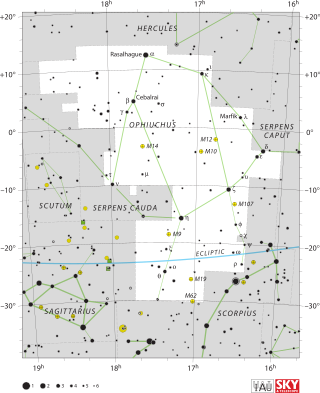
Ophiuchus is a large constellation straddling the celestial equator. Its name comes from the Ancient Greek ὀφιοῦχος (ophioûkhos), meaning "serpent-bearer", and it is commonly represented as a man grasping a snake. The serpent is represented by the constellation Serpens. Ophiuchus was one of the 48 constellations listed by the 2nd-century astronomer Ptolemy, and it remains one of the 88 modern constellations. An old alternative name for the constellation was Serpentarius.

Maximilian Franz Joseph Cornelius Wolf was a German astronomer and a pioneer in the field of astrophotography. He was the chairman of astronomy at the University of Heidelberg and director of the Heidelberg-Königstuhl State Observatory from 1902 until his death in 1932.

Edward Emerson Barnard was an American astronomer. He was commonly known as E. E. Barnard, and was recognized as a gifted observational astronomer. He is best known for his discovery of the high proper motion of Barnard's Star in 1916, which is named in his honor.

The Horsehead Nebula is a small dark nebula in the constellation Orion. The nebula is located just to the south of Alnitak, the easternmost star of Orion's Belt, and is part of the much larger Orion molecular cloud complex. It appears within the southern region of the dense dust cloud known as Lynds 1630, along the edge of the much larger, active star-forming H II region called IC 434.

NGC 281, IC 11 or Sh2-184 is a bright emission nebula and part of an H II region in the northern constellation of Cassiopeia and is part of the Milky Way's Perseus Spiral Arm. This 20×30 arcmin sized nebulosity is also associated with open cluster IC 1590, several Bok globules and the multiple star, B 1. It collectively forms Sh2-184, spanning over a larger area of 40 arcmin. A recent distance from radio parallaxes of water masers at 22 GHz made during 2014 is estimated it lies 2.82±0.20 kpc. from us. Colloquially, NGC 281 is also known as the Pacman Nebula for its resemblance to the video game character.

The Lagoon Nebula is a giant interstellar cloud in the constellation Sagittarius. It is classified as an emission nebula and as an H II region.

The Small Sagittarius Star Cloud is a star cloud in the constellation of Sagittarius approximately 600 light years wide, which was catalogued by Charles Messier in 1764. It should not be confused with the nearby Large Sagittarius Star Cloud which lies about 10° to the south.

Barnard's Loop is an emission nebula in the constellation of Orion. It is part of the Orion molecular cloud complex which also contains the dark Horsehead and bright Orion nebulae. The loop takes the form of a large arc centered approximately on the Orion Nebula. The stars within the Orion Nebula are believed to be responsible for ionizing the loop.
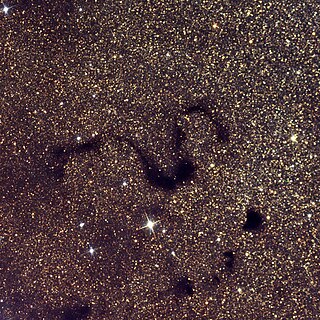
The Snake Nebula is a dark nebula in the Ophiuchus constellation. It is a small but readily apparent SP-shaped dust lane that snakes out in front of the Milky Way star clouds from the north-north-west edge of the bowl of the Pipe Nebula. Its thickness runs between 2′ and 3′ and runs around 6′ in the north-west / south-east orientation. A good view in a 4" to 6" telescope requires clear dark skies.
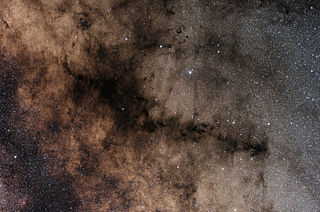
The Pipe Nebula is a dark nebula in the Ophiuchus constellation and a part of the Dark Horse Nebula. It is a large but readily apparent smoking pipe-shaped dust lane that obscures the Milky Way star clouds behind it. Clearly visible to the naked eye in the Southern United States under clear dark skies, but it is best viewed with 7× binoculars.
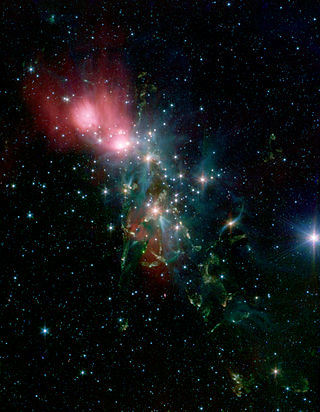
NGC 1333 is a reflection nebula located in the northern constellation Perseus, positioned next to the southern constellation border with Taurus and Aries. It was first discovered by German astronomer Eduard Schönfeld in 1855. The nebula is visible as a hazy patch in a small telescope, while a larger aperture will show a pair of dark nebulae designated Barnard 1 and Barnard 2. It is associated with a dark cloud L1450. Estimates of the distance to this nebula range from 980–1,140 ly (300–350 pc).
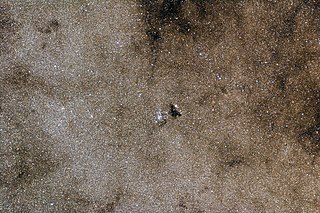
NGC 6520 is an open cluster in the constellation Sagittarius, superimposed upon the Large Sagittarius Star Cloud. It is magnitude 9.0, diameter 5 arc minutes and class G. It has about 25 stars of magnitude 9 to 12. The dark nebula Barnard 86 lies near its western edge.

IC 5146 is a reflection/emission nebula and Caldwell object in the constellation Cygnus. The NGC description refers to IC 5146 as a cluster of 9.5 mag stars involved in a bright and dark nebula. The cluster is also known as Collinder 470. It shines at magnitude +10.0/+9.3/+7.2. Its celestial coordinates are RA 21h 53.5m, dec +47° 16′. It is located near the naked-eye star Pi Cygni, the open cluster NGC 7209 in Lacerta, and the bright open cluster M39. The cluster is about 4,000 ly away, and the central star that lights it formed about 100,000 years ago; the nebula is about 12 arcmins across, which is equivalent to a span of 15 light years.

The "E" or "Barnard's E" Nebula is a pair of dark nebulae in the Aquila constellation. It is a well-defined dark area on a background of Milky Way consisting of countless stars of all magnitudes, getting its name from its resemblance to the letter E in the Latin alphabet. Its size is about that of the full moon, or roughly 0.5 degrees, and its distance from earth is estimated at 2,000 light years.
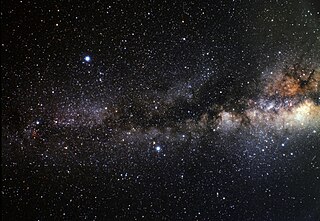
In astronomy, the Great Rift is a dark band caused by interstellar clouds of cosmic dust that significantly obscure (extinguish) the center and most radial sectors of the Milky Way galaxy from Earth's perspective.

The astronomer Edward Emerson Barnard compiled a list of dark nebulae known as the Barnard Catalogue of Dark Markings in the Sky, or the Barnard Catalogue for short. The nebulae listed by Barnard have become known as Barnard objects. A 1919 version of the catalogue listed 182 nebulae; by the time of the posthumously published 1927 version, it listed 369.
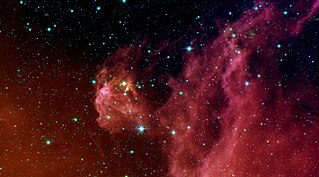
Barnard 30 is a dark cloud in the Lambda Orionis ring, north of Lambda Orionis, also called Meissa. The region is about 1300 light years from Earth.

The Large Sagittarius Star Cloud is the brightest visible region of the Milky Way galaxy, a portion of the central bulge seen around the thick dust of the Great Rift which lines the northwest edge. It should not be confused with the nearby Small Sagittarius Star Cloud, which lies about 10° to the north. The star cloud stretches several degrees north from the star Gamma Sagittarii and is considered a splendid sight in binoculars - "a bright glow with multitudes of momentarily resolved star-sparks". To the naked eye, the Cloud appears bright and smooth, and is said to resemble a puff of "steam" escaping from the spout of the Sagittarius "Teapot" asterism.


















